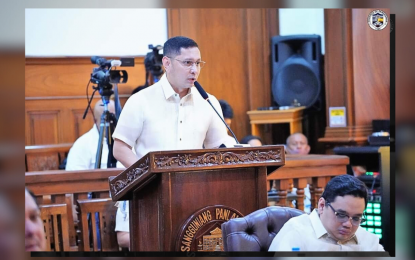
SOLAR POWER. Pangasinan Acting Governor Mark Ronald Lambino delivers a speech on the joint venture agreement between the provincial government and the San Miguel Holdings Corporation during the Sangguniang Panlalawigan session last May 8, 2023. Lambino, in an interview Thursday (Oct. 5), said the province eyes to produce 1.5 gigawatts of solar power by 2025. (Photo courtesy of Province of Pangasinan Facebook page)
LINGAYEN, Pangasinan – The provincial government of Pangasinan is eyeing to produce 1.5 gigawatts of solar power capacity by 2025 from the five renewable energy companies that are set to construct solar farms in the next few years.
In an interview Thursday, Pangasinan Vice Governor Mark Lambino said abundance of solar power in the province attracts renewable energy companies.
Among the companies that have acquired approval from the Sangguniang Panlalawigan (Provincial Council) to pursue solar energy production are the Sinocalan Solar Power Corporation for its 60-megawatt (MW) solar power project in Barangay Sto. Domingo, San Manuel; Renovable Earth Corporation that proposed the development and operation of 75.014MW peak (MWp) and 49.500 MW alternating power (ac) project in the villages of Pangascasan and ⁵/5Capantolan in Sual; PV Sinag Power Inc. that proposed the development and operation of 75 MWac and 146 gigawatt hour (GWh) generation capacity of Cayanga-Bugallon Solar Power Project in Barangay Cayanga, Bugallon.
PV Sinag Power Inc. also proposed the development and operation of 128 MWac and 254 GWh generation capacity of Laoag-Aguilar solar project in Barangay Laoag, Aguilar; and 3 Barracuda Energy Corporation, which proposed the development of a solar energy plant that have up to 650 MWp with an attached energy storage plant of up to 200 MW.
Lambino said these energy companies have secured the Solar Energy Operating Contract (SEOC) from the Department of Energy (DOE); the required papers from the Bureau of Investments (BOI); have complied or have an ongoing process for the issuance of an Environmental Compliance Certificate from the Department of Environment and Natural Resources (DENR); acquired or have an ongoing process for the acquisition of a Special Land Use Permit or a Forest Land Use Agreement.
He said they will continue to issue permits until the national government mandates the province to stop issuing permits.
“As far as the capacity of the province, as Governor Ramon Guico III has always said, the number one product of the province is our heat index or irradiation. Some of the solar farms are being set in the rolling terrains of the mountains,” he said.
Lambino said the provincial government and the Provincial Board are very careful in the approval of any investment being proposed to the province.
"In this administration, we entertain only those proponents who have at least passed the scrutiny of the national government and have gotten clearances from the corresponding national agencies. We have to ensure that they have the capacity of building the project, and they have the capacity to protect the environment when they implement their project," Lambino said.
Meanwhile, DOE-Luzon Field Office Director Renante Sevilla is encouraging government offices and the private sector, both the business establishments and individual consumers, to consider the use of renewable energy.
In an interview also on Thursday, Sevilla said that aside from the generation sector requirement, they also have programs for the demand sector.
"Now that we have the Energy Management Program, we are targeting at least 10 percent production savings. We will be visiting public and private schools and even commercial buildings to encourage them to have their own energy efficiency and conservation program. We will be doing some energy audit. We will help them to consider doable energy conservation methods, not necessarily requiring funding,” he said.
Sevilla disclosed that Urdaneta City-based Panpacific University uses renewable energy, with a total of 198 solar panels installed at the rooftop of its basic education building. The solar panels can generate 99 kilowatts (kW).
He said return of investment from the solar panels is projected to be in two-and-a-half to three years while lifespan of the solar panels is around 20 to 25 years. (PNA)
